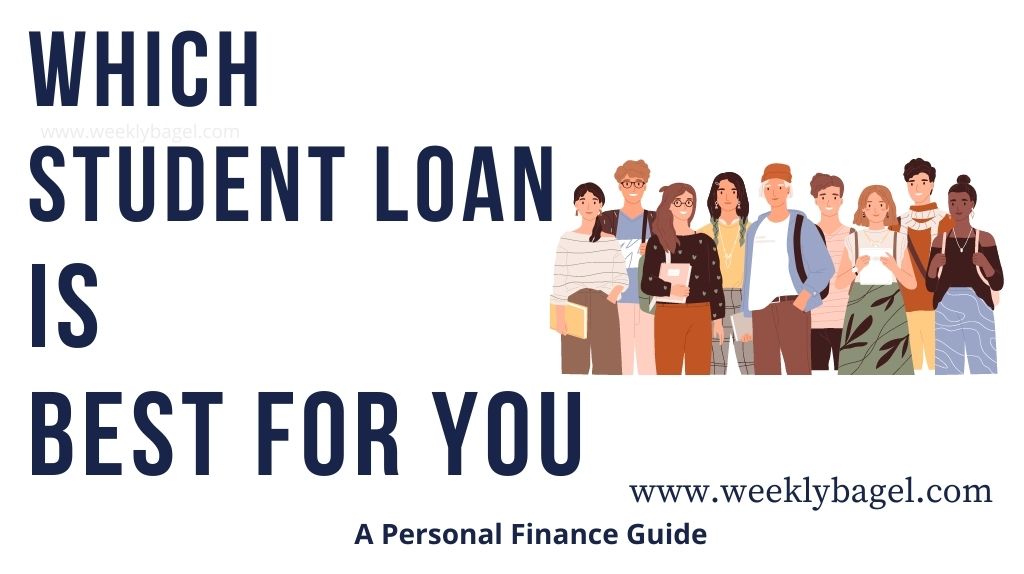
In the United States, the average cost of a Bachelor’s degree is $30,000. This is according to a 2022 student loan debt statistics from Education Data Initiative. The cost can get higher than this amount, depending on what kind of student loans you plan on borrowing.
This is why it is important to know which student is best for you, in order to avoid graduating with a heavy student loan debt.
Generally, there are two types of student loans for college. You have the private student loans and federal student loans. The federal government offers federal student loans, while banks offer private student loans. This is the difference between federal student loans and private loans.
Moreover, both loans vary immensely in their requirements, conditions and interest rates. Here is what I mean.
Federal Student Loans
30% of student borrowers go for this loan. This is because it is one of the easiest student loans to get approved for. As long as you meet the basic academic requirement, you will qualify for them.
Under federal student loan, it is further classified into three groups. Namely:
- Direct Subsidized loans
- Direct Unsubsidized Loans
- Direct Plus Loans
The first and second loans are guaranteed student loans with no cosigner. Here are where they differ from one another.
Direct Subsidized Loans For Undergraduate Students
This is a great loan for undergraduate students. It is one of the best student loans with crazy low interest out there. This is because the federal government pays the interest on the loan, while you are:
- Out of school for six months.
- In deferred payment.
- Taking college classes at least part-time.

You have to meet one of these conditions, otherwise you would have to pay back your student loan debt. As long as you are in school part-time, you will not pay a dime back until six months after you have left school. I highly recommend this loan for anyone planning on going to community colleges.
The current interest rate for Direct Subsidized Loans dispense on or after July 1, 2021 and before July 1, 2022 is 3.73%. Any Undergraduate student borrowing on or after July 1, 2022 and before July 1, 2023 will have an interest rate of 4.99%.
Naturally, this is not something to worry about. This is because the loan is a subsidized loan. The government pays its interest, while you are in school. But, there is a loan fee to pay though. This is especially when your loan is paid to you before October 1, 2023.
The loan fee is 1.057%. Do not worry about this fee. It is taken out of your student loan. So basically, you will not pay a single cent.
Finally, the annual award for Direct Subsidized Loan is up to $5,500. If you are a dependent- an adult with guardians, this amount changes. The same goes for independent adult students. Usually, it is higher for independent students.
Direct Unsubsidized Loans
This federal student loan is for undergraduate, graduate or professional degree-seeking students. The difference between Unsubsidized and Subsidized loans lie in their interest payment and award amounts.
Firstly, the government does not pay your interest for you while you are in school. You pay for the interest during the period of the loan. When you fail to do this, you accrue interest on your loan. The interest is added to your total debt.
Do not fret about it. No one is coming after you. There will not be debt collection calls. You can check my article on how I graduate college debt free, for tips on minimizing your student debt; this is to help you keep the interest payment low.
Next, the interest rate for this loan on or after July 1, 2021 and before July 1, 2022 is 3.73% for undergraduates and 5.28% for graduate level students. This interest rate will change after July 1, 2022. For loan disbursement on or after July 1, 2022 and before July 1, 2023:
- 4.99% interest rate for undergraduate level students.
- 6.54% interest rate for graduate level students.
Besides the changes, the award amount is basically the same. You can get up to $20,000 per academic year. But, this amount goes down when you get this loan together with a Subsidized Loan.
Additionally, the amount awarded depends on your dependence status and year in school. Do not worry though. The US Department of Education does not discriminate, regardless of whether you are independent or not.
Direct Plus Loan
This is a loan available to parents or graduate-level students. When it is given to parents on behalf of their dependent undergraduate children, it is called Parent Plus loan. Otherwise, it is grad PLUS loan.
Mostly, this loan is for taking care of academic expenses not covered by the other federal student loans. The amount awarded to you, depends on what other aid you have received. If you have received other federal loans, the cost of your school attendance is subtracted from the other loans; the balance is what you get.
Furthermore, the US Department of Education runs a credit check on you prior to giving you this loan. If you have serious financial needs though, you can still get this loan. A bad credit history may not affect your ability to get this loan, as long as you can demonstrate financial need.
Private Student Loans
These are loans offered by banks and other financial institutions. I will not be recommending any to you, since private education loans are for-profit. Do not get me wrong, they have their merits.
Here are some pros of private student loans:
- You have access to higher cash limit than Federal Student Loans.
- Fixed or Variable Interest rates.
- Sometimes, lower interest rates than federal student loans.
With that said, here are some cons of private student loans:
- There is no student loan forgiveness for private student loans.
- There is rarely a deferment in the case of financial difficulty.
- It affects your credit.
- There is no income-driven repayment plan.
As a freshman college student, private student loans should not be your first choice. This is because your loan starts accumulating interest from the month it is borrowed. Unlike the federal student loans, the private lender does not wait for you to graduate college to start paying it back.
13% of student borrowers go for private student loans. This is because the Federal Student Loans may not cover 100% of their education expenses. Especially, for majors like medicine, law or even a private university eduction.
Sometimes, you cannot help but get a private student loan. Some schools and majors create a ridiculous amount of academic expenses for the average student. Therefore, going for a private education loan may be inevitable.
private vs federal Student Loans

What student loan is best for you, good reader?
Private student loan may seem attractive, but I highly recommend using federal student loans. Max them out, until there is need for a private student loan. When such a need arises, combine private and federal student loans.
Federal student loans are better than private loans. Unlike banks and private lenders, the federal government does not want you paying back your student loan debt, until you have been out of school for six months. In fact, there are some federal student loan forgiveness programs for some highly demanded majors.
For example,
If you go to medical school on federal student loans, you can get 100% of your medical student loans forgiven. This is in as little as two years!
I cannot say the same for banks and other private lenders. No private lender is letting go of its money just like that. Hell, you can get sued for not paying back a private student loan debt. Did you know that?
Besides, the US Department of Education can defer your post-graduation student loan repayment in case of financial difficulties. Or even better, you can get your federal student loans forgiven due to disabilities.
As you can see, dear reader, the advantages of federal student loans outweigh the private student loans. This is not to say private student loans are bad. Nay- it simply means for the average college graduate who is going to struggle to get a job and pay down a student loan debt, it is better to go for federal student loans.




 How To Deposit A Check At Wells Fargo Bank
How To Deposit A Check At Wells Fargo Bank